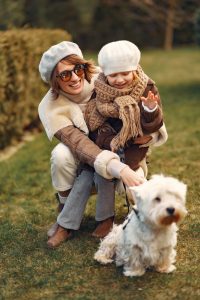Lick – all good?
On the Internet you can see many videos where a baby is lying next to a dog, crawling to it, wiggling towards it or touching it. Many dogs lick the baby’s face, look briefly at the camera and continue licking. Such pictures appeal to many people. Many wish to see exactly this relationship. You see love, care and closeness. Unfortunately, the reality is often not as rosy.
Not always loving?
Parents learn what exactly licking a baby or child can mean in every free Dogs and Storks and Dogs and Baby Connection lecture. It is important to know that it is often an indication that the baby or child is too close to the dog. For me personally it was difficult at first to believe that. The more I learned and the better I could read my bitch’s body language, one thing became clear to me: she often licked my daughter when she was overwhelmed with a situation.
But what can parents do?
First of all, it always makes sense to act and not just to react. In simple terms, this means getting ahead of the licking. There are different options. The adult sits between the dog and the baby, which provides privacy and both can still be in the same room. Alternatively, the adult can send the dog to the positively occupied place.
However, some dogs like to have a break from the hustle and bustle with the baby and should therefore be given the opportunity to leave the room and withdraw.
If the dog is already licking, it should under no circumstances be punished for this. Too great is the risk that it negatively links the baby. It is better to call the dog over to you and avoid such situations in the future, for example by sitting between the two.

Dogs don’t automatically know how to behave near babies
When a baby comes into the family, a lot changes. In the beginning, the behavior of the parents in particular is changed. Over time, the baby then begins to move more and crawl towards the dog if necessary. It is incorrect to assume that the dog knows how to handle a baby. Some dogs show fear behavior, others get excited, some are overwhelmed. It is up to the adult to show the dog that he does not have to be afraid to reward him for behavior in the presence of the baby and to show him what he can do. For safety reasons, dogs and babies should never be left alone. Only a really attentive adult can ensure a harmonious coexistence.
If 100% attention is not possible because, for example, as a parent you would also like to make a phone call or answer an email, security measures such as a children’s gate or a dog crate should protect baby and dog from an unpleasant encounter. Both can be pleasantly linked for the dog during pregnancy.
Learn to stroke
Babies don’t instinctively know how to handle the dog. Babies have a great need to get to know the world. A lot is gripped, pressed, put in the mouth. This is important for the development! The child may want to painfully explore the dog’s tail, paws, or even ears. Neither of them learn what we want. The dog learns that the baby hurts him. The baby learns to handle dogs like this. Stroking should therefore always be done by an adult.
Jeniffer Shryock taught me how this can look. A parent holding the baby on her lap invites the dog to come. If possible, the adult should not lean over the dog from above, but sit to the side of him. The child should learn from the beginning to stroke only with one hand. Two hands quickly lead to hugs that dogs sometimes endure, but usually don’t enjoy.
Note: it is an invitation. If the dog does not want to come, it should not have to. Dogs that do not want to get close to babies should always know that they are allowed to walk.
Graduation
Give them both baby and dog time to get to know each other. Nobody wants to be forced to interact – that is not the basis of a harmonious coexistence. Time and help from the adults help both of them to become a good team.











